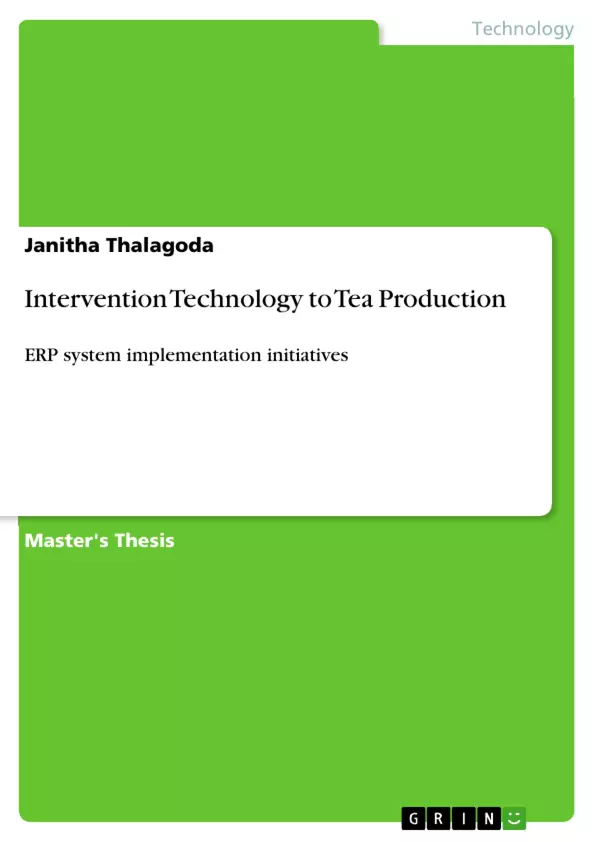This report describes the approach to develop tea manufacturing industries with the finest product in Sri Lanka and top contributor of gross domestic product. Currently tea produces use of labour and machine contribution. To improve the production process, firstly it required information flow with executives to make better decisions, thus, requirement of condition monitoring in real time has a slight edge for executives to analyse this information. To improve this, the enterprise resource planning system has to be an added advantage. Initialising this kind of system required a strategy to provide links to the system and executives. Establishment phase is required kind of instincts of current manufacturing system. feedback from respective categories from top to bottom in its hierarchy is very essential to develop the structure of design of software systems. This system is able to maintain streamline required information to certain parties, essential to something like corporate dissension making. This kind of system needs feedback to keep on updating information availability to resource allocation and labour allocation, in order to keep the production process smooth and identical. Degree of validity of information that is extracted by the system is useful for keeping on the track of the optimal way of tea manufacturing. The ERP base system has incurred those characteristics.
Inhaltsverzeichnis (Table of Contents)
- Introduction
- Chapter Overview
- Introduction
- Problem Domain / Background
- Problem Definition
- Problem Statement
- Project Motivation
- Project Aims and Objectives
- Project Resources
- Concept Map
- Existing Work
- Literature review
- Technology/Approaches/Algorithms Review
- Tools and Techniques
- Requirements Analysis
- Chapter overview
- System review
- Project Scope
- In scope
- Out scope
- Prototype Feature Diagram
- Stakeholders Diagram
- System Hardware Resource Requirements
- Software Resource Requirements
- System Design
- Chapter overview
- Use Case Diagram
- Sequence Diagrams
- Class Diagrams
- Entity-Relation Diagram
- UI design
- Implementation
- chapter overview
- System Architecture
- Review of Technologies
- Implementation discussion
- Conclusions
- Testing
- Objectives and Goals of Testing
- Testing Criteria
- Functional Testing
- Accuracy Testing/Security Testing/Performance Testing
- Limitations of the testing process
- Social, Legal, Ethical and Professional Issues
- Conclusions & Evaluations
- Evaluation Methodology and Approach
- Evaluation Criteria
- Self-Evaluation
- Selection of the Evaluators
- Evaluation Result
- Domain Experts
- Technical Experts
- Focus Group Testing
Zielsetzung und Themenschwerpunkte (Objectives and Key Themes)
This report details the development of an enterprise resource planning (ERP) system for Sri Lankan tea manufacturing industries, aiming to optimize production processes and contribute to the country's economic growth.
- Analyzing the current tea manufacturing processes and identifying challenges.
- Designing and developing an ERP system to improve information flow, resource allocation, and decision-making.
- Implementing and testing the ERP system to ensure its functionality and effectiveness.
- Evaluating the social, legal, ethical, and professional implications of the ERP system.
- Contributing to the advancement of Sri Lankan tea manufacturing through technology integration.
Zusammenfassung der Kapitel (Chapter Summaries)
- Introduction: This chapter provides an overview of the project, including the problem definition, motivation, aims, and objectives. It discusses the current state of tea manufacturing in Sri Lanka and the challenges associated with its production process. It also explores existing work in the field, including relevant literature, technologies, and tools.
- Requirements Analysis: This chapter outlines the requirements for the proposed ERP system. It defines the system's scope, identifies stakeholders, and analyzes hardware and software resource requirements. This chapter also presents diagrams like the prototype feature diagram and stakeholders diagram.
- System Design: This chapter details the design of the ERP system, including use case diagrams, sequence diagrams, class diagrams, entity-relation diagrams, and user interface design. This chapter provides a blueprint for implementing the ERP system.
- Implementation: This chapter discusses the implementation of the ERP system, including system architecture, review of technologies, and implementation details. It provides insights into the technical aspects of the development process.
- Testing: This chapter describes the testing process for the ERP system, outlining the objectives, criteria, and methodologies employed. It covers various testing aspects, including functional testing, accuracy testing, security testing, and performance testing. It also discusses the limitations of the testing process.
- Social, Legal, Ethical and Professional Issues: This chapter examines the social, legal, ethical, and professional implications of implementing the ERP system in tea manufacturing industries. It analyzes potential impacts on workers, the environment, and society as a whole.
Schlüsselwörter (Keywords)
The main keywords and focus topics of this report include web development, ERP systems, database designing, tea manufacturing, information flow, resource allocation, decision-making, and technology integration.
- Citar trabajo
- Janitha Thalagoda (Autor), 2024, Intervention Technology to Tea Production, Múnich, GRIN Verlag, https://www.grin.com/document/1501001



